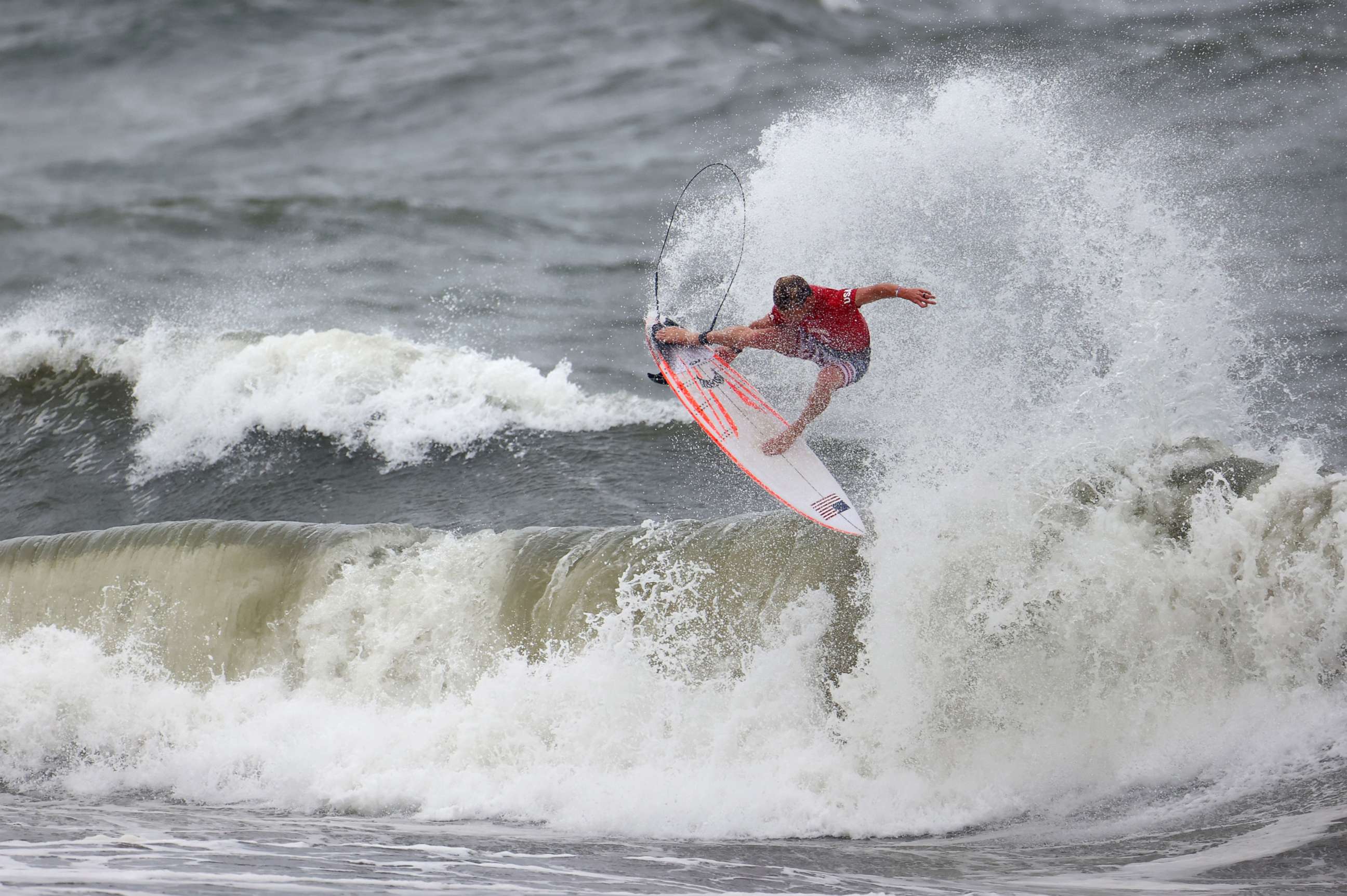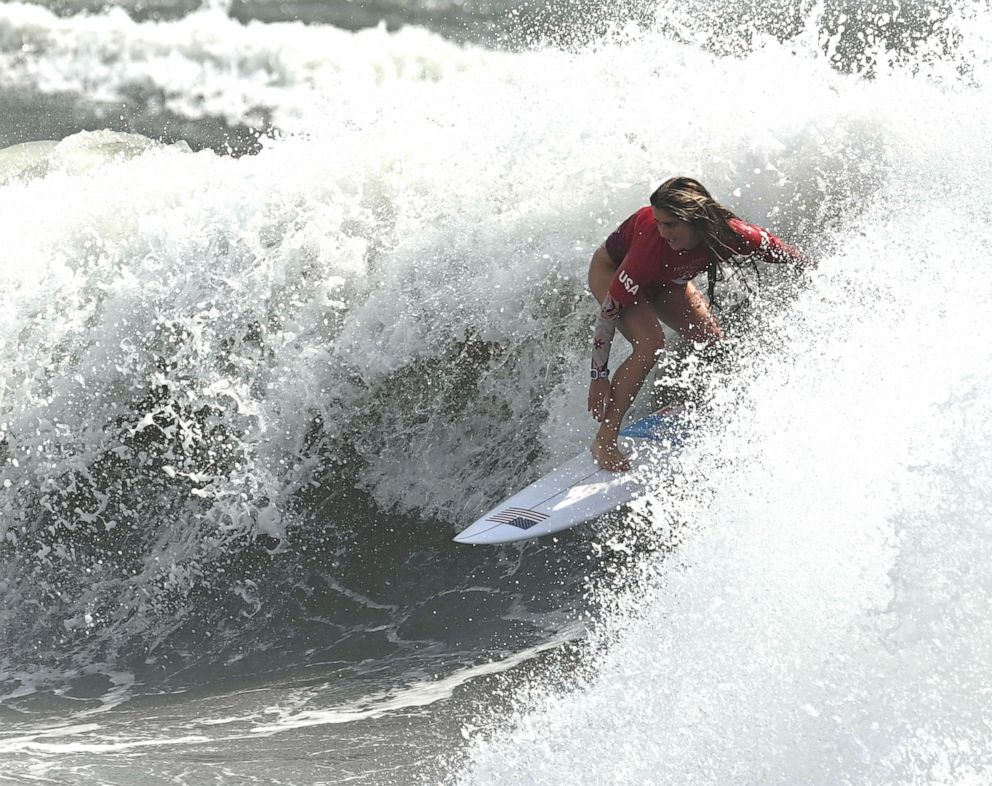Americans make their mark in Olympic surfing
'Now it’s time to have fun," said Team USA surfer Carissa Moore.
Three of the four members of Team USA have advanced to the quarterfinals of surfing's debut at the Tokyo Olympics with Caroline Marks and Kolohe Andino emerging from the waters off Japan's Shidashita Beach with the highest scores in the opening heats.
For Andino, 27, of San Clemente, California, who holds seven USA Surfing Champion titles, victory was bittersweet because he knocked teammate John John Florence, 28, of Oahu, Hawaii, out of the competition during a head-to-head faceoff on Monday.
Andino earned the highest score in the first two days of competition with an 8.5 out of a possible 10 from the judges on a ride he described as "really rad and one for the history books."
With waves churned up to 7 feet by a developing typhoon far north of Shidashita Beach, Andino nailed what an announcer described as a "slob frontside air reverse" in which he caught air off the lip of a wave, grabbed onto his surfboard with one hand and landed on the face of the wave in a reverse position before spinning forward.

On the women's side, Team USA's 19-year-old Caroline Marks and Carissa Moore, 28, of Honolulu, the world's No. 1 ranked surfer, both moved on to the quarterfinals.
Moore, who holds four World Surfing League titles, narrowly defeated Peru’s Sofia Mulanovich, 38, in a one-on-one competition on Monday.
Marks, the sixth-ranked female surfer in the world, enters the quarterfinals after achieving the highest overall score of any woman or man in the third round of the inaugural surfing event. In her two best heats she scored an 8 and 7.33 for a combined total of 15.33.
Organizers of the first-time event have scheduled an eight-day waiting period -- July 25 to Aug. 1 -- to squeeze in up to four days of competition based on daily conditions -- wave heights, direction, wind strength.
Kurt Korte, the international surf forecaster for the Olympic surfing event, told ABC News that conditions off the Pacific Coast of Japan are looking good for the remainder of the week. In his latest forecast for Surfline.com, Korte said surfers can expect smaller waves for the quarterfinals on Tuesday, with "peaky swell mix in the head-high range with well overhead sets."

Korte said Tropical Cyclone Nepartak well off Japan's Pacific Coast was easing up and not producing the bigger more challenging waves competitors saw over the weekend.
16 to surf it out in quarterfinals
Sixteen of the 40 surfers from 17 countries who qualified for the Olympics move onto the quarterfinals. But big stars in the surfing world like Florence and Australia's Stephanie Gilmore, a seven-time world champion, were eliminated in the earlier rounds.
"It wasn’t my best performance but sometimes you’ve just got to take those heat wins and roll with it," Moore, now the heavy favorite to win gold, said after squeaking into the quarterfinals. “It was crazy to see some top seeds bow out earlier this morning. It just goes to show that these conditions are very tricky."
How the competition will work
The surfers qualified for the Olympics based primarily on how well they did at previous major competitions, including the 2019 World Surfing League Championship Tour, where Florence and Moore each came out on top.
The Olympic Games are exclusively a shortboard affair, meaning surfboards are less than 7 feet long, with pointy noses and usually three small fins on the underside.
A five-judge panel bases scores on a scale of 1 to 10 that can include decimal points. Competitors are judged on speed, power, snap turns and how seamlessly they flow on a wave. Judges also look for difficulty, risk and innovation of maneuvers performed, such as a barrel, or riding through the tube a curling wave makes, and aerials in which surfers ride up the face a wave and catch air at the lip.
In April, Moore wowed spectators at the Rip Curl Newcastle Cup, the second leg of the World Surf League's Championship Tour, by nailing an aerial where she landed a reverse on the face of a wave before spinning another 180 degrees forward. The judges gave her a near-perfect score of 9.9.
Surfing fans are watching to see if Moore will perform the maneuver again on the world's biggest stage.

In each heat, surfers are given a 30-minute window to catch as many waves as possible but must go one at a time, with the surfer closest to the peak of a wave given preference to catch it. Participants can be docked points for violating surfing etiquette by cutting in line.
The best two scores from each surfer will decide who moves on to the semifinals round and, eventually, the medal round.
Following her first day of competition on Sunday, in which Moore won a tough battle with Teresa Bonvalot of Portugal, Moore admitted to having Olympic jitters.
"I actually had a little mini-meltdown because of all the nerves and the anxiety and stuff that had built up," Moore said during a press conference.
Since then she said she has felt a "sense of calm" with each round of surfing.
"Whatever happens, I’ve done everything I could, and now it’s time to have fun," Moore said.
For more Olympics coverage, see: https://abcnews.go.com/Sports/Olympics




